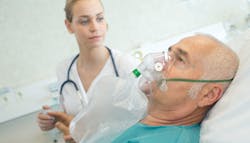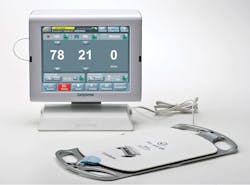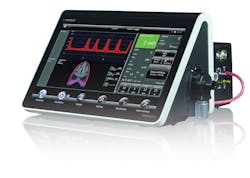With increasing respiratory diseases, 2019-nCoV (coronavirus)/other respiratory illness outbreaks and routine surgical, emergency room (ER) and intensive care unit (ICU) care, OR and hospital teams must concentrate on keeping their patients breathing steadily. This means the critical need to produce, learn and use the best respiratory monitoring and care technology to treat patients.
Rise of respiratory monitoring
MarketWatch points to the “Global Respiratory Care Devices Market Trends, Applications, Analysis, Growth, and Forecast to 2027” report stating, “Factors such as high prevalence of respiratory diseases such as chronic obstructive pulmonary disease (COPD), tuberculosis, asthma and pneumonia, rising urbanization and pollution levels, increasing incidence of pre-term births, increasing geriatric population, high prevalence of smokers, and changing lifestyle are fueling the growth of the global respiratory care devices market. In addition, rising demand for cutting-edge technologies, increasing per capita income and rising demand for respiratory devices in private sector hospitals and clinics are other factors attributed to market growth.” 1
Non-invasive, invasive or mechanical ventilation, sensors and other equipment help monitor and measure the ups and downs of patients’ breathing, conditions and other vital functions while in the OR, hospital, home or other settings. These devices are continuously advancing on a global scale with automated, mobile-enabled, wearable, smaller-sized, portable and noncontact capabilities, according to the Transparency Market Research “Respiratory Monitoring Devices Market” report.2 Among the report findings:
- “Companies in the respiratory monitoring devices market landscape are increasing R&D activities to develop wearable sensors that are capable of detecting respiration under various ambulatory conditions. These sensors are built on the technology of medical grade continuous spirometers. The spirometers product segment is expected to reach value of US $1.1 Bn by the end of 2027.
- Companies in the respiratory monitoring devices market are focusing on providing convenience of patients by increasing offerings in portable battery-powered capnometers to measure CO2. Since traditional capnometers in hospitals are bulky bedside machines, manufacturers are innovating in miniaturized capnometers that can be used as a patient’s personal respiratory monitor.
- Manufacturers in the respiratory monitoring devices market are increasing their production capabilities to develop advanced pulse oximeters. The pulse oximeters product segment is estimated to reach a value of US $3.4 Bn by 2027. However, lack of training and resources has slowed down the adoption of pulse oximeters, especially in developing countries. Lack of training for healthcare professionals has led to increased death rates from anesthesia. Manufacturers are combining the technology of smartphones with pulse oximeters.”
Ins and outs of technology and treatment
As respiratory treatment is essential, it also poses unique challenges – from complexity of equipment, patients’ health status, lack of staff education and more. In this article, we asked industry professionals to weigh in with insights and latest products for respiratory monitoring and care.
Another factor is the shifting nature of health and the hospital. Differences in patients, revolving equipment and settings as well as insufficient staff training can complicate care, notes Lisa Rose, Chief Marketing & Innovation Officer, Vyaire Medical. “Respiratory care and monitoring in the OR and hospital can be especially challenging because every breath counts – yet everything is in a state of flux. At its most acute point, clinicians and doctors need to move patients through the hospital and make life and death decisions in real time. Yet, everybody’s history and circumstances are unique. Added to that, hospital environments are continually changing and equipment continues to evolve. One particular challenge is that sometimes there are compatibility issues with equipment. Clinicians must have the right training and knowledge to ensure those challenges don’t jeopardize the patient.”
Rose cited differences in ventilation equipment and mask use as other potential issues. “Not all ventilators are created equal. Not all non-invasive ventilators can do invasive support well and not all invasive ventilators can do non-invasive support well. Additionally, non-invasive support requires a patient interface (mask) that must be appropriately sized and comfortable for the patient; if not, it can result in discomfort or skin breakdown and patient refusal to continue its use.”
Ventilation support and obstacles
Ventilators are crucial for assisting patients with breathing during care, but may end up causing serious health complications. Conditions can include lung damage, oxygen toxicity, blood clots, skin infections and vocal cord damage, addressed the National Heart, Lung and Blood Institute (NHLBI). 3
Edwin Coombs, MA, RRT, NPS, ACCS, FAARC, Senior Director of Marketing, Portfolio Training Solutions, Clinical Affairs & Intensive Care, Draeger, Inc. explained, “The prolonged use of invasive ventilation can lead to VAE/VAP (ventilator-associated event/ventilator-associated pneumonia) and other pulmonary complications. A proactive and protective ventilation strategy must always be employed.”
Coombs continued, “Postoperative pulmonary complications (PPC) can have significant consequences for high-risk surgical patients (abdominal, orthopedic, and neurologic) ultimately leading to poor outcomes and extended admissions into the ICU.”
Further, “According to Zhan et al., postoperative respiratory failure (not including pulmonary embolism) added approximately 9 hospital days to hospital length of stay, greater than $53,000 to hospital costs, and an almost 22% increase in mortality. It is thus evident that postoperative respiratory complications have significant and widespread sequelae for both the patient and the health care system,” reported in, “The Role of Capnography to Prevent Postoperative Respiratory Adverse Events” in the Anesthesia Patient Safety Foundation Newsletter.4
Evolution of ventilation machines
Healthcare providers can breathe easier knowing ventilation systems continue to become more sophisticated, automated, adaptable, integrated, visual, therapeutic and safety-driven in respiratory monitoring, data collection and care. Ventilation machines can help benefit patients in breathing through several stages of treatment as well as aim to prevent harmful health events in the OR, hospital and beyond.
He pointed to their Evita Infinity V500 for its automation, safety and comfort. “Our mechanical ventilator for post-op care and the ICU is the Evita Infinity V500. The V500 has a significant set of features to benefit a caregiver’s workflow including the ability to provide invasive ventilation, non-invasive ventilation and high-flow 02 therapy with one device. Enhanced safety features are integrated into the user interface screen to support early decision making and facilitate corrective actions during alarm conditions. Additionally, a day/night screen and configurable alarm volume can support patient comfort. It offers a wide range of therapeutic tools for lung protection and monitoring of ventilation parameters. Automated weaning protocols and tools support clinicians when to liberate patients from mechanical ventilation.”
Vyaire Medical’s line of respiratory products caters to patients throughout critical care, shares Rose. “We have a broad portfolio of products and solutions that are very much a part of the OR and post-op care. Our sole focus is respiratory care and how it impacts the entire continuum of care.”
Growth of sensor devices
As earlier mentioned, respiratory monitoring devices are advancing, including portable, wearable, smaller and noncontact products like spirometers, capnometers and pulse oximeters. These sensors help benefit patients in breathing and strive to stop dangerous health events through automated data measurement and care in the hospital, other healthcare settings or at home.
The EarlySense sensor system is placed within a patient’s furniture in acute or post-acute care, and measures heart rate, respiratory rate and motion, states O’Malley. “EarlySense has introduced a non-invasive and non-patient contact sensor, which is placed between the bedframe and the mattress. The contact-free sensor can also be used in a chair. This technology was designed for the non-acute care areas and provides continuous monitoring, with accuracy comparable to more complex critical care technology without the need to tether the patient. The respiratory cycle is analyzed through the sensor measurement and processing through our algorithms, accomplished twice per second. Our sensor captures waveshapes that the body produces, whether it is gross body motion, the cardiac cycle or the respiratory cycle. We then incorporate these signals into a processing device (monitor), which is built within an overall system, all designed to alert staff of a potential adverse event, which can be motion-related such as a potential unsupervised patient fall or a respiratory depression.”
He emphasized the system’s success in reducing hazardous circumstances. “The EarlySense system has been used with more than a million patients in hospitals as well as post-acute facilities. In addition, a version of our EarlySense sensor is being used in the Verily Baseline Study. The purpose of our sensor’s use in this study is related to sleep. In hospitals and post-acute facilities, the EarlySense system is used to assist caregivers in avoiding adverse events, such as fall prevention, respiratory depression and other cardiac or respiratory events. Fall rates have been shown to reduce in the range of 40%, there has been a reduction of code blue events in the 60-80% range, and post-acute care facilities have shown to reduce admission rates by almost 20%.”
Future of care
What more is in store for respiratory monitoring and care?
Coombs envisions continued automated monitoring, data and prevention in care. “The trend today and for the foreseeable future is the development of automated systems that are geared to minimize complications arising from mechanical ventilation. Early warning systems and data dashboards will be created to provide practical information to alert clinicians to acute changes and act preemptively to avoid further complications. Non-invasive applications for monitoring a patient’s pulmonary status are being explored and show a promising horizon.”
Rose forecasts expanded non-invasive monitoring and data among care providers. “We believe that non-invasive support is one of the fastest growing areas in respiratory care. Respiratory disease is a global issue and continues to grow every year. As we look to the future, there are opportunities across all segments to better equip care providers and improve patient outcomes. The more we understand the challenges, the more we will be able to successfully help care providers improve safety and predictability, leverage data, increase mobility and versatility and tailor care – regardless of the care environment.”
She reported Vyaire Medical’s ongoing product development in the industry, including pulmonary function tests (PFTs), which “measure lung volume, capacity, rates of flow, and gas exchange,” defines Johns Hopkins Medicine. 5
“Two of the latest Pulmonary Function Test technologies were introduced in the U.S.: Vyntus BODY and Vyntus ONE, both with SentrySuite software. Internationally, SuperNO2VA, the exclusive nasal PAP ventilation mask was brought to market. And, we made two telemetry adaptors available for the U.S. market: ApexPrFH and MX40. We look forward to sharing other new products as they become available,” Rose stated.
Non-contact monitoring and data will advance in care settings, predicts O’Malley. “We believe that every area across the healthcare continuum can benefit from contact-free sensing. I believe that sensor technology will continue to evolve allowing the ability to monitor more patients in more environments, with relative ease. Within hospitals, this may be expanding where we monitor and collect data from patients. Within post-acute facilities, it may be that we provide more analytics to organize information so that less overall interpretation may be needed. And in the home, we believe in simpler patient and family interfaces for the technologies still providing the advanced monitoring and data collection required.”
References
1. Respiratory Care Devices Market Rising Demand and Current Trends 2019 to 2028, “Global Respiratory Care Devices Market Trends, Applications, Analysis, Growth, and Forecast to 2027,” https://www.marketwatch.com/press-release/respiratory-care-devices-market-rising-demand-and-current-trends-2019-to-2028-2019-04-30
2. The Transparency Market Research “Respiratory Monitoring Devices Market”, https://www.transparencymarketresearch.com/respiratory-monitoring-devices.html
3. National Heart, Lung and Blood Institute, Ventilator/Ventilator Support: https://www.nhlbi.nih.gov/health-topics/ventilatorventilator-support
4. “The Role of Capnography to Prevent Postoperative Respiratory Adverse Events” in the Anesthesia Patient Safety Foundation Newsletter.
5. Johns Hopkins Medicine, What are pulmonary function tests?, https://www.hopkinsmedicine.org/health/treatment-tests-and-therapies/pulmonary-function-tests
About the Author

Ebony Smith
Ebony Smith was previously Managing Editor for Healthcare Purchasing News.



